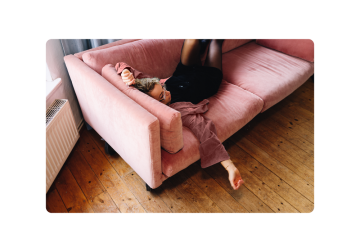N26 has published its latest research on consumer spending in 2023, focused on European spending habits across generations. The research analyzed 12 months of transaction data of over 9,000 customers across Austria, Germany, France, Italy, and Spain. The study reveals distinct spending patterns among different generations, with younger Europeans focusing on learning, housing, and shopping, while older generations prioritized food, transport, and travel.
The data, derived from anonymized customer transactions made over the course of 2023, shows the average expenditure per category of spend as a percentage of the total average expenditure for each generation. This method provides a clear view of how different age groups allocate their budgets across various spending categories.
Baby Boomers in Spain Embrace Lifelong Learning

While Spain consistently demonstrated the highest percentages of money spent on learning across all age groups, it's the Baby Boomers and Gen Z who stood out with their unwavering commitment to personal growth. Expenditures in this category included but were not limited to school supplies, colleges and universities and other educational services such as cooking, ceramics, language, music schools and continuing education programs.
Generation Z consistently led the way when it came to investing in learning and self improvement in all the countries examined, with Spanish Gen Z allocating an impressive 32.63% of their spending towards acquiring new knowledge and skills, followed by Italians and French (23.5%), Germans (22.45%) and Austrian youngsters (13.34%).
While younger generations spending more on learning and education is natural, the Baby Boomer generation in Spain was found to devote around a fifth of their overall spending (19.56%) to acquiring new knowledge and skills. This dedication to lifelong learning sets them apart from their age groups in Austria (10.45%), Germany (13.39%), Italy (15.66%), and France (17.88%).
European Spending Habits on Learning by Generation
| Austria | 10.45% | 11.86% | 12.78% | 13.45% |
| Germany | 13.39% | 15.97% | 17.84% | 22.45% |
| Spain | 19.56% | 23.41% | 23.13% | 32.63% |
| France | 17.88% | 20.27% | 19.19% | 23.48% |
| Italy | 15.66% | 19.37% | 20.57% | 23.50% |
Increased shopping expenditure correlates with younger age:
Austrian Gen Z top among European youth

Younger Europeans were also found to dedicate more of their spending to shopping compared to older generations. Austria's Gen Z led in shopping expenditures, allocating a significant 16.75% of their total spending to this category. Moreover, Austria stood out across all generations, consistently showing higher outlays in comparison to its European counterparts on the shopping category which included expenditures on fashion, sports apparel, jewelry, second hand shops among others.
In contrast, Spain showed a more conservative approach to spending on discretionary purchases, with lower percentages across all age groups in shopping, where Baby Boomers and Gen X spent less than 11% of their total expenditures on this category. Millennials (12.29%) and Gen Z (12.75%) were in the middle of the range. French Gen Zs also stood out, ranking second in their generation for shopping expenditures, while the older French generations allocated less compared to their counterparts in other countries. Germany presented a model of consistency, with all generations showing similar spending behaviors, with percentages ranging narrowly from 13.82% to 14.22% out of their total expenditure. The country showed a slight uptick in shopping spending from Millennials, continuing the trend of gradual increases across younger generations. Meanwhile, in Italy, there was a noticeable trend of shopping expenditure decreasing as consumers age, with Baby Boomers spending the lowest proportion of their total expenditure to Gen Z spending the highest.
European Spending on Shopping by Generation
| Austria | 14.60% | 15.87% | 14.92% | 16.75% |
| Germany | 14.20% | 13.95% | 13.82% | 14.22% |
| Spain | 10.62% | 10.95% | 12.29% | 12.75% |
| France | 11.31% | 11.64% | 12.71% | 15.58% |
| Italy | 11.09% | 11.34% | 11.98% | 13.38% |
Older Generations Relish Their Financial Freedom to Travel

Austria exhibited the highest travel spending across all generations, with Baby Boomers leading at 34.38%. This trend may be explained by Baby Boomers likely having more disposable income and free time for travel compared to other age groups. Across all countries that were part of the study, Baby Boomers consistently allocated more of their budget to travel expenses than other generations. Generation X and Millennials showed more uniform travel spending patterns, with fewer fluctuations between countries than were seen in other demographic groups.
Travel spending decreased with each younger generation across the analyzed countries. Notably, there was a significant reduction in travel expenditure among Gen Z, especially in France and Spain, where the figures were on average 5.58 percentage points lower than among Baby Boomers. This trend may be due to economic limitations, evolving lifestyle preferences, or a preference for different types of experiences across various groups. Correspondingly, as younger generations face constraints like limited time and increased travel costs, they tend to allocate their funds towards immediate satisfaction, such as shopping and they travel on a tighter budget.
European Spending on Travel by Generation
| Austria | 34.38% | 32.43% | 30.72% | 28.27% |
| Germany | 32.87% | 31.32% | 29.31% | 26.22% |
| Spain | 28.35% | 28.41% | 28.19% | 22.42% |
| France | 27.16% | 27.43% | 26.47% | 21.93% |
| Italy | 30.50% | 29.64% | 27.85% | 24.81% |
French Pet Lovers: Wallets Open Wide for Furry Friends

France emerges as a standout, with Baby Boomers and Millennials particularly indulgent, spending 15.75% and 15.47% of their total expenditures on pets, respectively. This trend aligns with the Cat Ownership Research, which notes that 32% of French households own at least one cat, underscoring a deep-rooted culture where pets are an integral part of everyday life. Spending on pets was the lowest amongst Gen Z in Spain at just 9.47%. Meanwhile, Italy displays a high level of enthusiasm for pets among its younger generations, with Gen Z spending exceeding their generation in other countries studied, and also topping all generations in the country at 14.18%. Germany and Austria present a picture of stability with consistent spending on pet related expenses across generations, subtly peaking with Millennials at 11.98% and 12.61% respectively.
European Spending on Pets by Generation
| Austria | 11.13% | 11.41% | 12.61% | 11.09% |
| Germany | 10.12% | 10.71% | 11.98% | 10.76% |
| Spain | 12.54% | 11.57% | 11.62% | 9.47% |
| France | 15.75% | 14.56% | 15.47% | 12.69% |
| Italy | 13.35% | 12.45% | 13.65% | 14.18% |
The Love for Food Drives Spending Across Italian Generations

The comparative analysis of inter-generational spending on food across several European nations unveils some compelling insights, particularly highlighting the intersection of cultural traditions and economic trends. Italy consistently records the highest expenditure on food - be that groceries, restaurants, bakeries, or specialty food retailers - with Baby Boomers and Gen X spending 6.51% and 6.20% respectively, illustrating a cultural affinity towards food-related activities. Conversely, Germany shows lower spending in this category across the board, where expenditure is highest at 5.71% among Baby Boomers but stands at just 3.74% with Gen Z. Spain's youngest generation, Gen Z, spends the least on food at only 3.27% across all countries and generations studied, while France demonstrates consistency in food expenditure across generations, with only a minor discrepancy from 5.61% in Baby Boomers to 4.00% in Gen Z, suggesting a sustained cultural value placed on food and dining.
European Spending on Food by Generation
| Austria | 5.11% | 4.99% | 4.71% | 4.26% |
| Germany | 5.71% | 5.55% | 4.80% | 3.74% |
| Spain | 5.33% | 4.53% | 4.03% | 3.27% |
| France | 5.61% | 4.95% | 4.73% | 4.00% |
| Italy | 6.51% | 6.20% | 5.38% | 4.34% |
Stable Spending Patterns on Housing and Utilities:
Contrasting Gen Z Habits in Europe

Based on the findings on housing and utilities of the study, in 2023 spending remained relatively stable across all countries and generations, with an approximate range of 10.5% to 14% of total expenditure allocated to this category.
Notably, in Austria (14.16%), Germany (12.29%), and France (12.05%), the Gen Z stands out as the group that spends the most on housing and utilities, in line with expectations for a demographic which is still gradually building their income and spending power. On the other hand, in Italy and Spain, young adults in the Gen Z demographic allocate a lower percentage of their total spending on housing and utilities than those in older generations, with figures of 10.5% and 10.63% respectively.
European Spending on Housing and Utilities by Generation
| Austria | 11.95% | 11.65% | 12.49% | 14.16% |
| Germany | 11.68% | 11.39% | 11.60% | 12.29% |
| Spain | 12.19% | 11.16% | 11.02% | 10.63% |
| France | 11.13% | 11.28% | 11.40% | 12.05% |
| Italy | 11.26% | 10.49% | 10.68% | 10.50% |
Transportation and Leisure:
Consistent Spending Across Borders and Ages

The data shows that spending on transportation sees only modest variations across different countries and age groups, from a high of 6.76% among German Baby Boomers to a low of 3.87% for Spanish Gen Z. Notably, there's a consistent trend of declining transportation expenditures from Baby Boomers to Gen Z across all nations, with Spain experiencing the most significant decrease, 5.72% to 3.87%.
European Spending on Transportation by Generation
| Austria | 6.47% | 5.65% | 5.01% | 5.08% |
| Germany | 6.76% | 5.80% | 4.60% | 4.27% |
| Spain | 5.72% | 4.59% | 4.27% | 3.87% |
| France | 5.85% | 5.10% | 4.92% | 4.61% |
| Italy | 6.03% | 5.18% | 4.37% | 4.16% |
Similarly to transportation, expenditures on leisure in Austria and Germany are higher among younger generations, with Austria's Gen Z leading at 6.94%. In contrast, Spain sees decreasing spending on leisure with each younger generation, with its Gen Z spending the least at 4.95%. Meanwhile, France and Italy display unique patterns — France sees a resurgence in leisure interest among its younger populations, whereas Italy shows stability across all age groups.
European Spending on Leisure by Generation
| Austria | 5.92% | 6.14% | 6.76% | 6.94% |
| Germany | 5.28% | 5.31% | 6.06% | 6.05% |
| Spain | 5.69% | 5.37% | 5.45% | 4.95% |
| France | 5.31% | 4.78% | 5.10% | 5.66% |
| Italy | 5.59% | 5.34% | 5.52% | 5.13% |
Methodology
The study was conducted on a group of more than 9,000 customers from five countries - Austria, Germany, Spain, France, and Italy, examining spending data from January 1 to Dec 31, 2023 in the following categories:- Learning — wide range of categories including but not limited to tuition fees, student accommodation, school supplies, continuing education programs, cooking-, drama-, music-, ceramics-schools, flying instructions etc.
- Food— groceries, candy, dairy, bakery goods, restaurants, etc.
- Housing and utilities — electric, gas, TV, phone, furniture repairs, etc.
- Leisure — books, media and digital goods, theater, dancing, sports, other hobbies, etc.
- Pets — pet food and supplies, veterinary services, beds, toys, grooming, etc.
- Shopping — fashion and apparel, jewelry, footwear, second hand stores
- Transportation — local and suburban commuting, petrol and electric vehicle charging, vehicle service shops, tire repairs, etc.
- Travel — airline fares, car rental, accommodation, etc.
- Baby Boomers — Aged 60 and above
- Generation X — Aged 45 to 59, known for bridging the gap between Baby Boomers and younger generations.
- Millennials — Aged 30 to 44, distinguished by their digital proficiency during the internet boom.
- Generation Z — Aged 18 to 29, deeply immersed in digital culture from a young age.
About N26
About N26
N26 is Europe’s leading digital bank with a full German banking license. It offers simple, secure and customer-friendly mobile banking to millions of customers in 24 markets across Europe. N26 processes over 140bn EUR in transactions a year and currently has a 1,500-strong team of more than 90 nationalities. The company is headquartered in Berlin, with offices in multiple cities across Europe, including Vienna, Paris, Milan and Barcelona. Founded by Valentin Stalf and Maximilian Tayenthal in 2013, N26 has raised close to US$ 1.8 billion from some of the world’s most renowned investors.
Website: n26.com | N26 Press Contact: press@n26.com
